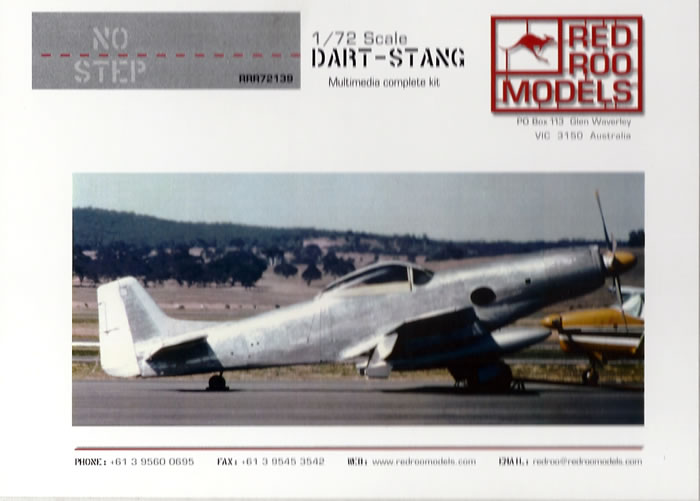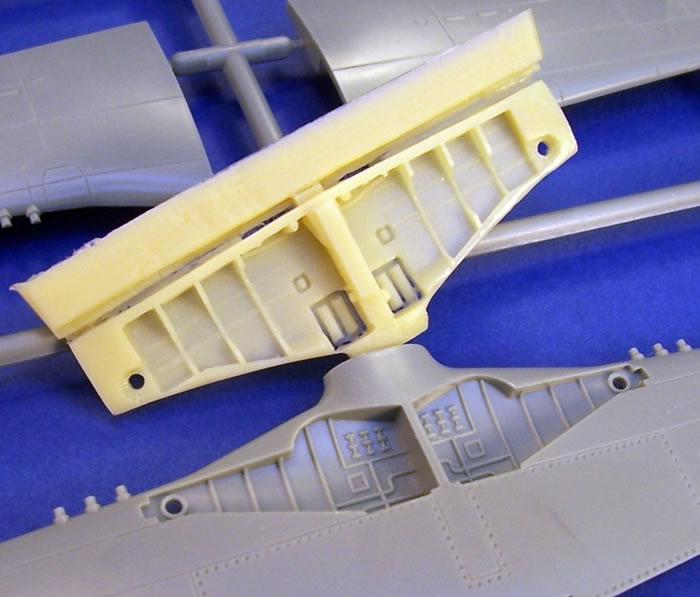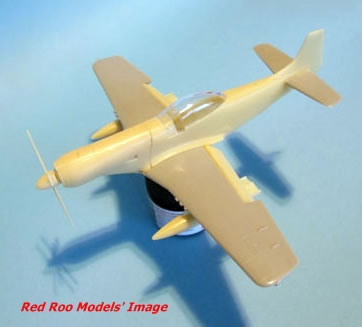Aerosmith Aviation Services
Dart-Stang

Red Roo Models, 1/72 scale
S u m m a r y : |
Catalogue Number: |
Red Roo Models Kit No. RRR72139 - Aerosmith Aviation Services Dart-Stang |
Scale: |
1/72 |
Contents & Media |
One Academy P-51D long run injected kit, supplied bagged and without decals.
The conversion parts consist of thirteen resin pieces, one hypodermic needle, four lengths of wire, and two small lengths of plastic strip. |
Price: |
AUD$25.45 available online from Red Roo Models |
Review Type: |
First Look. |
Advantages: |
Very thorough instructions, well-researched, good donor parts, very good resin components, innovative fix to the donor kit’s dihedral issue, and great value. |
Disadvantages: |
None worth mentioning. |
Conclusions: |
It is unusual, but not unheard of, to find a kit of an aircraft that never flew. This is a very good quality package to build an extremely obscure subject. I think that the Dart-Stang will appeal most to Aussie modellers no doubt, or those who have a thing for turboprop Mustangs.
This package offers great value, and a good quality model should result from this conversion.
I know it might not be everyone’s cup of tea, but for those who it is I highly recommend it. |
Reviewed by
Mark Davies

HyperScale is proudly supported by
Squadron.com
The Dart-Stang was the brainchild of a Sydney businessman, Hockney Treloar. He had acquired an ex-RAAF CA-18 Mustang Mk.22 and had a Rolls-Royce Dart 510 turboprop from a Vickers Viscount to repower it. He planned to build a plane that would cruise at an estimated 500-mph, and have a maximum speed of 540-mph. These speeds may seem optimistic, but weighing 1,300-lbs less than the Mustang; it is fair to assume that the performance would have been sprightly.
Hockney Treloar purchased the Mustang in 1969 from the Chieftain Aviation Flying School. The flying school had the Mustang mounted on a pole after buying it from Air Training Pty who used it for spares. Air Training Pty acquired it in 1961 from Adastra Aerial Surveys. Aubrey Oates owned it prior to its use for aerial survey work. He obtained it from RH Grant Trading Company, which was the first owner when the Australian Department of Supply in disposed of the CA-18 in 1958.
The Dart-stang was ready for engine runs with flight-testing planned for mid-1975. However, it was around this time that work on the project ceased. The Dart-stang passed through yet more hands and reverted to Merlin power. Frank Boreman, the famous astronaut, was the final buyer. Square One Aviation, based in Chino, California, completed the aircraft’s restoration. The CA-18 had now become a TF-51D, and at last flew on December 16th, 1996.
Perhaps sadly, for some at least, the Dart-stang was a case of close but not cigar. It was an interesting hybrid, although it was by no means the only turboprop conversion of a P-51D. Even if the Dart-stang had flown, I think that it would always have been destined for reconversion to Merlin power as a warbird. I suspect most readers of this review will prefer that this was in fact the outcome.
The Contents
This conversion comes in a sturdy flip-top box with a photograph of the Dart-stang on its front. It combines a bagged Academy P-51D kit with Red Roo’s resin conversion parts.
Richard Hourigan mastered the resin parts, and Czech Master Resin Moulding & Casting manufactures them for Red Roo.
The resin parts also come in a plastic bag, as do some raw materials for scratch-building small details. The P-51D kit comes with its own instructions, although they are not required for much because Red Roo’s instructions address all aspects of assembly.
The instructions provide a lengthy account of the airframe’s history, rather just the Dart-stang story. Printed in colour on A-4 pages, they give very detailed notes, include diagrams, and provide plans for templates. Also included are a parts map, some detail sketches, and close-up images of a restored Mustang. The text includes colour call-outs cross-referenced to FS.595. The Dart-Stang did not carry any markings so no decals are required. Well-drawn, four-view plans to 1/72-scale round out the instructions. It is obvious from this that Red Roo done a lot of research into this project.
The donor kit is fortunately the second and improved P-51D issue by Academy; the first one had seven exhaust stacks per side amongst other faults! The kit has its good and bad points. Several of the bad points relate to the fuselage and prop, which the conversion replaces. The conversion retains the kit’s good cockpit interior, but replaces the seat with a resin one; this is to simulate the different wooden type fitted to CAC Mustangs. Red Roo also directs the builder to correct the length of Academy’s tail-wheel by using a spacer.

The donor kit’s main purpose is to provide the flying surfaces. The wing’s dihedral and the leading edges of its flaps are both incorrect. However, Red Roo has solutions to both problems as detailed later. The ejector ports are too large and the wing guns that all protrude from the wing by the same amount. In addition, the fairings forward of the ailerons look exaggerated on the wing’s upper surface, and are missing from its underside. Finally, the wingtip lights should be teardrop shaped. These points are all easy to correct however. I think the choice of donor kit is fine because it has a good basic cockpit interior and wings with separate flaps. No doubt, using an Academy kit also helped to keep the total cost down as well.
The resin conversion parts appear virtually faultless, and have thin and easy to remove casting blocks. I did find some small pinholes on the prop, but these will be easy to deal with. The conversion focuses on the fuselage, but makes some important changes to the donor kit’s wings as well. The fuselage comes in two halves from the firewall back to the rudder. The fuselage halves have nice cockpit sidewall detail. A separate panel to fills what was the radiator area on the fuselage’s underside. The Dart engine cowling is a single piece with a separate exhaust, and there is a new prop and spinner. The prop has a small brass axle fitted in place. Two CAC Sabre drop-tanks, a CAC pilot’s seat, two CAC eight-spoke wheels, main wheel wells, and flaps complete the list of resin components. Also supplied is a Hypodermic needle (with plastic sheath) and some lengths of fine wire in two gauges. These are use to make the model’s undercarriage door retraction rams and the seat frame. Finally, the conversion provides two small lengths of plastic strip that are for cockpit braces that replace the seat armour.
The Airframe
Red Roo’s instructions explain the conversion in thorough detail. They also have templates to assist with establishing the correct angle for dropped flaps, undercarriage doors and wing dihedral. A number of detail changes are necessary to alter the P-51D’s avionics and seat armour to the layout used by the Dart-Stang. The ejection ports need filling; there are small underside wing fences to add, and a gun- camera port, and undercarriage door hinges to fashion. The instructions cover these matters in depth, and indicate that a great deal of research has gone into this project.
Red Roo has a very clever approach to fixing the dihedral of the donor kit’s wing. They first require the removal of the kit wheel well from the lower wing. Then they replace the kit wheel well with a better and more accurately detailed part. This sets the correct dihedral once fixed in place. The instructions advise to reinforce this area with plastic strip cut using the dihedral diagram they include as a guide.

A nice feature of the Academy kit separate flaps, but their squared off leading edges spoil this aspect of the kit. Resin flaps that have the correct profile solve this problem. There is also a template to assist with setting the flaps at the correct angle.
The instructions deal with the undercarriage area at some length. Most of this relates to the undercarriage doors and their retraction rams. The length of the text is due to the need to describe how to scratch-build detail parts using the hypodermic needle and wire provided with the conversion. There are measurements, diagrams and photos to assist with this. The instructions also advise how to position the tail-wheel correctly using a small block of plastic. Many other small items require attention, and the instructions cover these in detail. They end with guide notes on the bare metal finish of the original.
Some care is necessary to remove the donor kit’s wheel well, and the undercarriage hinges could be fiddly to scratch-build. These points aside, the rest of the conversion should be easy to cope with. Building Red Roo’s Dart-stang ought to be an enjoyable experience.
It is unusual, but not unheard of, to find a kit of an aircraft that never flew. This is a very good quality package to build an extremely obscure subject. A good quality model should result from this conversion.
I think that the Dart-Stang will appeal most to Aussie modellers no doubt, or those who have a thing for turboprop Mustangs.

Value is a very subjective matter, and First Look reviews do not normally comment on it for this reason. However, you would have to be a miserable scrooge to deny that this conversion package offers a lot for the price.
I know it is not everyone’s cup of tea, but for those who it is I highly recommend it.
Thanks to Red Roo Models for the review samples.
Review Text & Blue Background Images Copyright © 2012 by Mark Davies
Page Created 9 July, 2012
Last updated
9 July, 2012
Back to HyperScale Main Page

|
